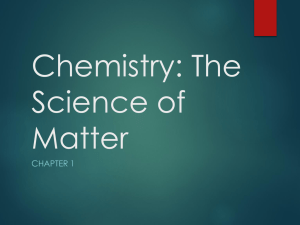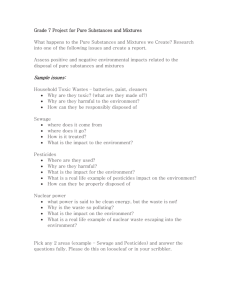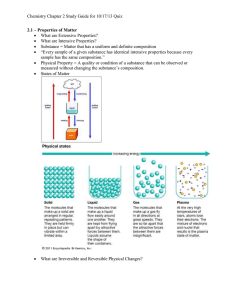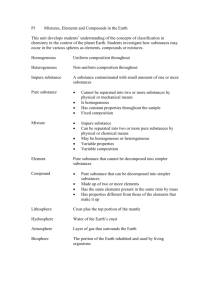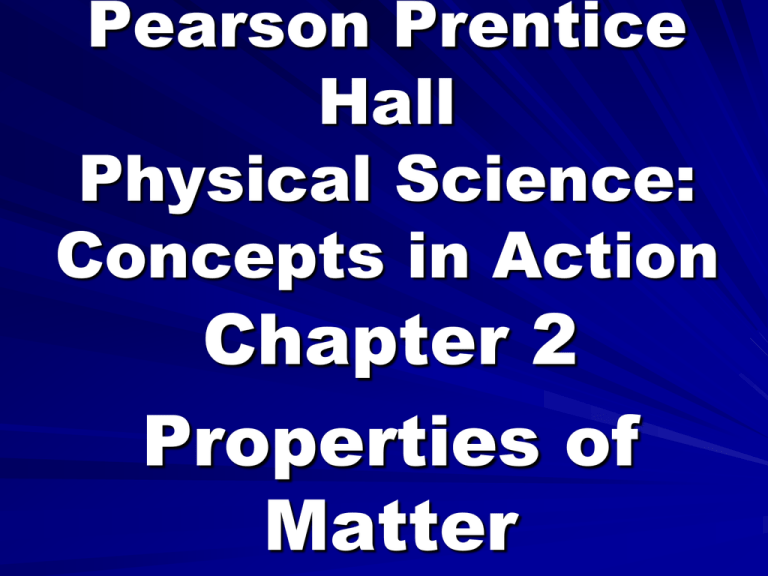
Pearson Prentice
Hall
Physical Science:
Concepts in Action
Chapter 2
Properties of
Matter
2.1 Classifying Matter
Objectives:
1. Explain why elements and
compounds are classified as
pure substances
2. Distinguish mixtures and
pure substances
3. Analyze the main difference
among solutions, suspensions
& colloids
Definition: a pure substance is
matter that always has exactly
the same composition
Any particular pure substance
always has the same properties
because the substance has a
fixed, uniform composition
Definition: an element is a
substance that cannot be
broken down in simpler
substances
Elements as pure substances
Elements contain only one type of
atom
Elements have a fixed composition
(due to only one type of atom)
Examples of elements: gold (Au),
silver (Ag) and platinum (Pt)
Names of elements have one or two
letters
If there is a second letter, it is not
capitalized
http://www.chemicool.com/
Compounds as pure substances
Definition: a compound is a
substance that is made from 2 or
more simpler substances, AND can
be broken down into simpler
substances
A compound always contains 2 or
more elements joined in a fixed
proportion
Since compounds are matter that
always contain the exact same
elements in the exact same
proportions, they are pure
substances
Mixtures are not pure
substances
Recall that a pure substance is
matter that always has exactly the
same composition
Mixtures vary in composition so they
are not pure
The properties of a mixture can vary
because the composition of the
mixture is not fixed
Example: salsa- one batch may have
more onions, fewer tomatoes or tons
of peppers compared to another
batch
Different types of mixtures
Definition: a heterogeneous
mixture is not the same
throughout
Example: fruit salad
Definition: a homogeneous mixture
is the same throughout
Example: rubbing alcohol or milk
Mixtures are also classified by the
size of the largest particles as
solutions, suspensions or colloids
Solutions, Suspensions & Colloids
Definition: a solution is substances
that dissolve into each other to form a
homogeneous solution (& do not
separate into layers)
Definition: a suspension is a
heterogeneous mixture that separates
into layers over time such as sand &
water
Definition: colloids are heterogeneous
mixtures that are made of very tiny
particles & some intermediate sized
particles of pure substances
disbursed in another substance that
do not settle out or separate such as
gelatin
Examples of physical
properties
Definition: a physical property is any
characteristic of a material that can
be observed or measured without
changing the composition of the
material
Here are some examples:
Viscosity- resistance of a liquid to
flowing
Conductivity- ability of material to
allow heat to flow
Malleability- ability of a solid to
be hammered without shattering
Hardness- resistance to
scratching
Melting point- the temperature at
which a substance changes form
solid to liquid
Boiling point- the temperature at
which a substance boils
Density- the ratio of mass to
volume or m/v
2.2 Physical Properties
Objectives:
1. Give examples of physical
properties
2. Explain the usefulness of
knowing physical properties
3. Describe how mixtures are
separated
4. Evaluate when a physical
change has occurred
Usefulness of Physical Properties
Physical properties are used
to identify a material, to
choose a material for a
specific purpose or to
separate substances from a
mixture
The methods often involve
math since many physical
properties are described by
numbers (boiling point and
melting point, for example)
Separating Mixtures
There are several ways
Here are some examples:
Filtration- separating substances
based on the size of the particles
(sand from water, for example)
Distillation- separation of
substances based on their boiling
points (requires that the boiling
points are different from each
other)
Magnetism- using magnetic
property of some metals to
separate from nonmagnetic
materials
Density- some substances may
float (less dense) in water,
while others sink: using density
this way allows separation of
less dense substances from
more dense substances such
as driftwood floating on water
Recognizing Physical
Changes
Definition: a physical change
is a change in the physical
form or properties of a
substance that occurs without
a change in composition
The substances in the
material remain the same
Size and shape might change
but not composition
Words that describe
physical change
Examples of physical change
include cutting, grinding,
bending, water changing to
steam, melting of ice
Some words that describe
physical change: boil, freeze,
dissolve, melt, condense, break,
split, crack, crush and dissolve
2.3 Chemical Properties
Objectives:
1. Discuss when chemical
properties can be observed
2. Summarize which
observations might indicate a
chemical change has occurred
3. Judge the difference
between a chemical and
physical change
Physical or Chemical?
When matter undergoes a
chemical change, the
composition of the matter
changes
When matter undergoes a
physical change, the
composition of the matter
remains the same
Observing Chemical
Properties
Definition: a chemical property
is the ability to produce a
change in the composition of
matter
Chemical properties can be
observed only when substances
in a sample of matter are
changing into different
substances
Two types of chemical
properties include
flammability and reactivity
Definition: flammability is a
material’s ability to burn in the
presence of oxygen
Definition: reactivity is the
ability of a substance to
combine chemically with
other substances
Observations of chemical
change
Change in color, production of
gas, formation of precipitate
Definition: a precipitate is any
solid that forms when 2 liquids
are mixed
Other examples of chemical
change: Burn, rot, rust,
decompose, ferment, explode
and corrode


